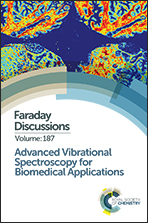High resolution FTIR imaging provides automated discrimination and detection of single malaria parasite infected erythrocytes on glass†
Abstract
New highly sensitive tools for malaria diagnostics are urgently needed to enable the detection of infection in asymptomatic carriers and patients with low parasitemia. In pursuit of a highly sensitive diagnostic tool that can identify parasite infections at the single cell level, we have been exploring Fourier transform infrared (FTIR) microscopy using a Focal Plane Array (FPA) imaging detector. Here we report for the first time the application of a new optic configuration developed by Agilent that incorporates 25× condenser and objective Cassegrain optics with a high numerical aperture (NA = 0.81) along with additional high magnification optics within the microscope to provide 0.66 micron pixel resolution (total IR system magnification of 61×) to diagnose malaria parasites at the single cell level on a conventional glass microscope slide. The high quality images clearly resolve the parasite's digestive vacuole demonstrating sub-cellular resolution using this approach. Moreover, we have developed an algorithm that first detects the cells in the infrared image, and secondly extracts the average spectrum. The average spectrum is then run through a model based on Partial Least Squares-Discriminant Analysis (PLS-DA), which diagnoses unequivocally the infected from normal cells. The high quality images, and the fact this measurement can be achieved without a synchrotron source on a conventional glass slide, shows promise as a potential gold standard for malaria detection at the single cell level.
- This article is part of the themed collection: Advanced Vibrational Spectroscopy for Biomedical Applications

 Please wait while we load your content...
Please wait while we load your content...